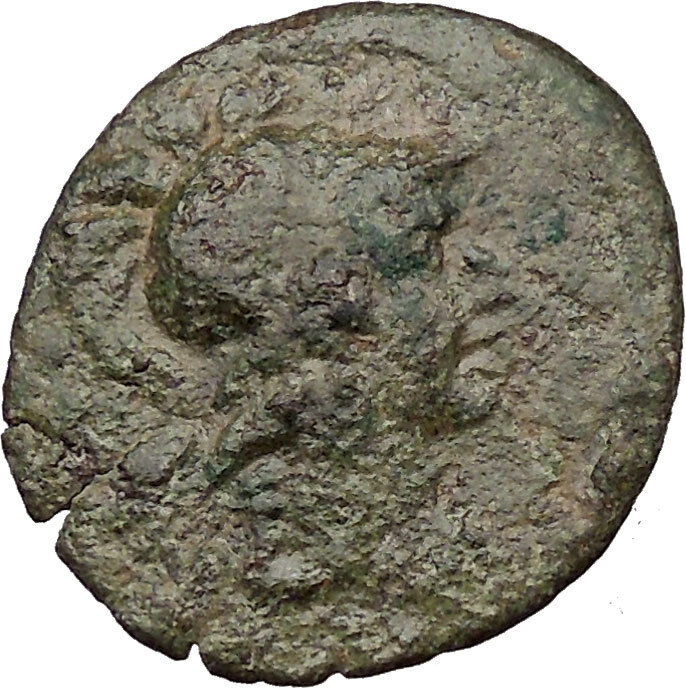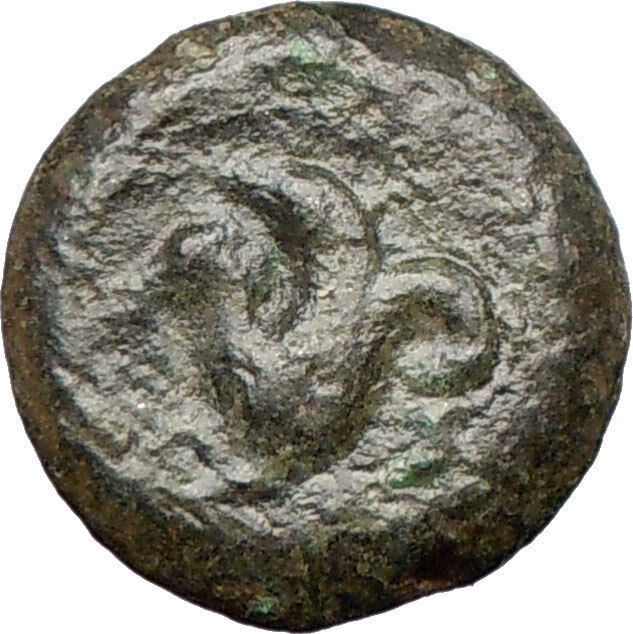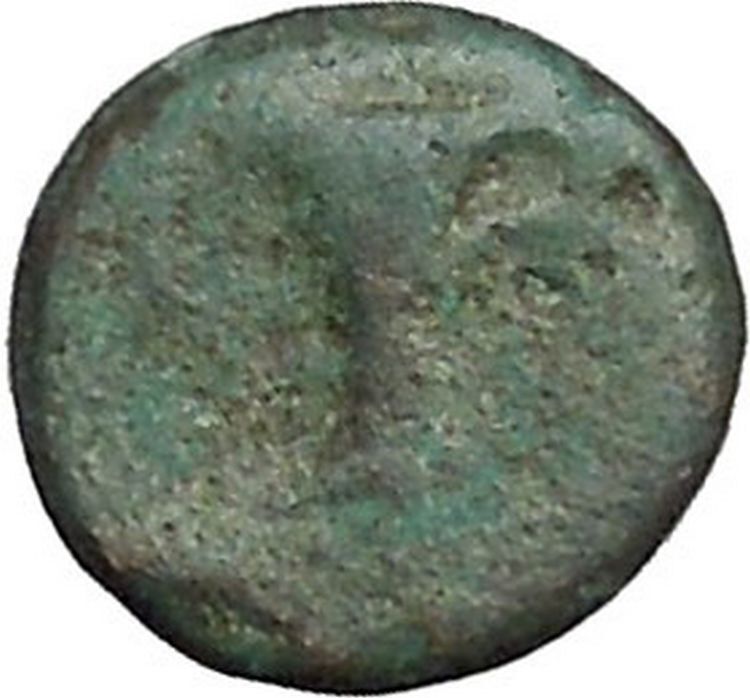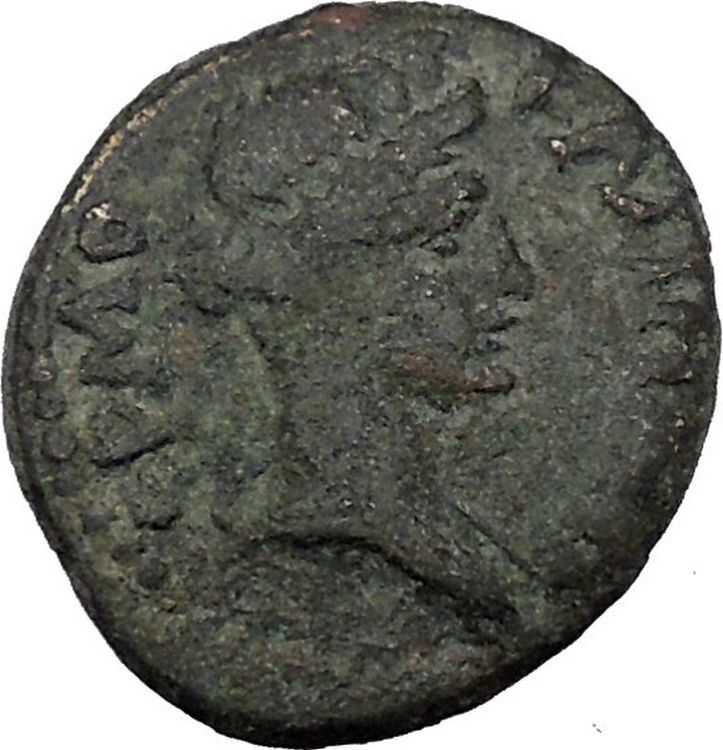|
Baktria
, Indo-Greek Kingdom in India
Menander I
, Soter- King: 160-145 B.C.
Silver Drachm 16mm (2.11 grams) Struck 160-150 B.C.
Uncertain mint in the Paropamisadai or Gandhara
Reference: HGC 12, 188; Bopearachchi Serie 7
ΒΑΣΙΛΕΩΣ ΣΩΤΗΡΟΣ
MENANΔPOY “Of Saviour King Menander”
– Heroic bust of the king, viewed from behind, head turned to left,
wearing diademed and aegis, and thrusting with spear held in right hand.
Athena standing right, brandishing thunderbolt and holding aegis; Karosthi
legend around: Mahrajasa tratarasa Menamdrasa “of Great King Menander the
Savior” ; monogram to left..
This king was famous in Buddhist narrative as king “Milinda”,
who was said to have been a convert to Buddhism after debating philosophical
points with the sage Nagasena. Perhaps the best-known of the Indo-Greek kings,
Menander was appointed by Eukratides to rule the areas south of the Hindu Kush.
His colleages in this task were Apollodotos and, later, Zoilos. According to
Buddhist tradition, in which he is named Milinda, Menander was a just and
powerful ruler and a convert to Buddhism.
You are bidding on the exact item pictured,
provided with a Certificate of Authenticity and Lifetime Guarantee of
Authenticity.
Athena
or Athene (Latin:
Minerva
),
also referred to as Pallas Athena, is the goddess of war, civilization,
wisdom, strength, strategy, crafts, justice and skill in
Greek mythology
.
Minerva
,
Athena’s Roman
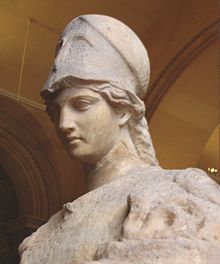
incarnation,
embodies similar attributes. Athena is also a shrewd companion of
heroes and the
goddess
of heroic
endeavour. She is the
virgin
patron of Athens
.
The Athenians built the
Parthenon
on the Acropolis of her namesake city, Athens, in her honour (Athena Parthenos).
Athena’s cult as the patron of Athens seems to have existed from the earliest
times and was so persistent that archaic myths about her were recast to adapt to
cultural changes. In her role as a protector of the city (polis),
many people throughout the Greek world worshiped Athena as Athena Polias
(“Athena of the city”).
Athens
and Athena bear etymologically connected names.
Menander I Soter “The Saviour” (known as Milind in
Indian sources) was the
Indo-Greek
king (165//155 BC-130 BC) who established a large empire in the
South Asia
and became a patron of
Buddhism
Menander was born in the
Caucasus
,
and was initially a king of
Bactria
.
He eventually established an empire in the
Indian subcontinent
stretching from the
Kabul River valley
in the west to the
Ravi River
in the east, and from the
Swat River valley
in the north to
Arachosia
(the
Helmand Province
).
Ancient Indian writers indicate that he launched expeditions southward into
Rajasthan
and as far east down the
Ganges River Valley
as Pataliputra
(Patna),
and the Greek
geographer
Strabo
wrote that he “conquered more tribes than
Alexander the Great
.”
Large numbers of Menander’s
coins
have been unearthed, attesting to both the flourishing commerce and duration of
his realm. Menander was also a patron of the
Buddism
,
and his conversations with the Buddhist sage
Nagasena
is recorded in the important Buddhist work, the
Milinda Panha
(“The Questions of Milinda”). After his death in 130 BC, he was succeeded by his
wife Agathokleia
who ruled as regent for his son
Strato I
.
Buddhist tradition relates that he handed over his kingdom to his son and
retired from the world, but
Plutarch
relates that he died in camp while on a military campaign, and that his remains
were divided equally between the cities to be enshrined in monuments, probably
stupas
,
across his realm.
Indo-Greek ruler
His territories covered the eastern dominions of the divided Greek empire of
Bactria
(modern day
or Bactria Province
ولایت بلخ) and extended to India (modern day regions
of the
NWFP
,
Punjab
in Pakistan and
Punjab
,
Haryana and parts of
Himachal Pradesh
and the Jammu
region) in present day India.
His capital is supposed to have been
Sagala
,
a prosperous city in northern
Punjab
(believed to be modern
Sialkot
),
Pakistan
.
He is one of the few
Bactrian
kings mentioned by Greek authors, among them
Apollodorus of
Artemita
, quoted by
Strabo
,
who claims that the Greeks from Bactria were even greater conquerors than
Alexander the Great
,
and that Menander was one of the two Bactrian kings, with
Demetrius
,
who extended their power farthest into India:
“The Greeks who caused Bactria to revolt grew so powerful on account of
the fertility of the country that they became masters, not only of Ariana,
but also of India, as Apollodorus of Artemita says: and more tribes were
subdued by them than by Alexander– by Menander in particular (at least if
he actually crossed the
Hypanis
towards the east and advanced as far as the
Imaüs
),
for some were subdued by him personally and others by
Demetrius
,
the son of
Euthydemus
the king of the Bactrians; and they took possession, not only of
Patalena
,
but also, on the rest of the coast, of what is called the kingdom of
Saraostus
and Sigerdis
.
In short, Apollodorus says that Bactriana is the ornament of Ariana as a
whole; and, more than that, they extended their empire even as far as the
Seres
and the Phryni
.”
(Strabo 11.11.1
[6]
)

2. Silver
drachm
of Menander I (155-130 BC).
Obv:
Greek
legend, ΒΑΣΙΛΕΩΣ ΣΩΤΗΡΟΣ ΜΕΝΑΝΔΡΟΥ (BASILEOS SOTEROS MENANDROU) lit.
“Of Saviour King Menander”.
Rev:
Kharosthi
legend: MAHARAJA TRATASA MENADRASA “Saviour King Menander”.
Athena
advancing right, with thunderbolt and shield.
Taxila
mint mark.
Strabo also suggests that these Greek conquests went as far as the capital
Pataliputra
in northeastern India (today
Patna
):
“Those who came after Alexander went to the
Ganges
and Pataliputra
”
(Strabo,
15.698).
The Indian records also describe Greek attacks on
Mathura
,
Panchala
,
Saketa
,
and Pataliputra
.
This is particularly the case of some mentions of the invasion by
Patanjali
around 150 BC, and of the
Yuga Purana
,
which describes Indian historical events in the form of a prophecy:
“After having conquered Saketa, the country of the Panchala and the
Mathuras
,
the
Yavanas
(Greeks), wicked and valiant, will reach Kusumadhvaja. The thick
mud-fortifications at
Pataliputra
being reached, all the provinces will be in disorder, without doubt.
Ultimately, a great battle will follow, with tree-like engines (siege
engines).” (Gargi-Samhita, Yuga Purana chapter, No5).
In the West, Menander seems to have repelled the invasion of the dynasty of
Greco-Bactrian
usurper
Eucratides
,
and pushed them back as far as the
Paropamisadae
,
thereby consolidating the rule of the Indo-Greek kings in the northern part of
the Indian Subcontinent.
The Milinda Panha gives some glimpses of his military methods:
“Has it ever happened to you, O king, that rival kings rose up
against you as enemies and opponents?
-Yes, certainly.
-Then you set to work, I suppose, to have moats dug, and ramparts
thrown up, and watch towers erected, and strongholds built, and stores of
food collected?
-Not at all. All that had been prepared beforehand.
-Or you had yourself trained in the management of war elephants, and
in horsemanship, and in the use of the war chariot, and in archery and
fencing?
-Not at all. I had learnt all that before.
-But why?
-With the object of warding off future danger.”
(Milinda
Panha, Book III, Chap 7)
His reign was long and successful. Generous findings of coins testify to the
prosperity and extension of his empire (with finds as far as Britain): the finds
of his coins are the most numerous and the most widespread of all the Indo-Greek
kings. Precise dates of his reign, as well as his origin, remain elusive
however. Guesses among historians have been that Menander was either a nephew or
a former general of the
Greco-Bactrian
king
Demetrius I
,
but the two kings are now thought to be separated by at least thirty years.
Menander’s predecessor in Punjab seems to have been the king
Apollodotus I
.
Menander’s empire survived him in a fragmented manner until the last Greek
king
Strato II
disappeared around 10 AD.
The 1st-2nd century CE
Periplus of the
Erythraean Sea
further testifies to the reign of Menander
and the influence of the
Indo-Greeks
in India:
“To the present day ancient drachmae are current in
Barygaza
,
coming from this country, bearing inscriptions in Greek letters, and the
devices of those who reigned after Alexander,
Apollodorus
[sic]
and Menander.”
-Periplus Chap. 47.[7]
Menander was the first Indo-Greek ruler to introduce the representation of
Athena Alkidemos (“Athena, saviour of the people”) on his coins, probably in
reference to a similar statue of Athena Alkidemos in
Pella
,
capital of
Macedon
.
This type was subsequently used by most of the later Indo-Greek kings.
The Baktrian and Indo-Greek Kingdoms
The ancient authors have furnished us with very little information concerning
this easternmost of all the Greek realms. Accordingly, the numismatic evidence
is of more than usual importance in the attempt to piece together the history of
the kings who ruled in Baktria and, later, in the area south of the Hindu Kush.
The kingdom was created from the Seleucid province of Baktro-Sogdiana when the
satrap Diodotos declared himself independent of Antiochus II about 256 B.C.
Antiochus III, at the end of the century, tried unsuccessfully to reimpose
Seleucid authority in the area, and early in the 2nd century B.C. King Demetrios
of Baktria extended his rule southwards to include former provinces of the
Mauryan Empire. The first bilingual coins, with inscriptions in Greek and
Karosthi and struck on new ‘Indo-Greek’ weight standard, date from this time of
Greek expansion. Much of Baktria was lost to Scythian invaders about 130 B.C.,
and before the end of the century what was left of the Indo-Greek kingdom split
into eastern and western divisions. By the end of the 1st century B.C. the last
traces of Greek rule had disappeared, submerged beneath the tide of Kushan
conquest.
|







